JH-3D Prototype
Custom 3D Print Service Silicon Mold Vacuum Casting Small Batch Plastic ABS PP PC Nylon POM Flexible Silicon Statues Parts Model
Custom 3D Print Service Silicon Mold Vacuum Casting Small Batch Plastic ABS PP PC Nylon POM Flexible Silicon Statues Parts Model
Couldn't load pickup availability
Notices
This is a link just to show our Silicon mold vacuum casting technologies and materials, please do not order directly.
If you have any requirements for small-batch plastic parts, please kindly contact us.

Silicon Mold Vacuum Casting
Small batch production
Multi Materials:
Standard ABS
Temperature-Resistant ABS
Flame-Retardant ABS
PP
PC
POM
Nylon
Silicon Shore 30A
Silicon Shore 40A
Silicon Shore 50A
Silicon Shore 60A
Silicon Shore 70A
Silicon Shore 80A
Silicon Shore 90A


What is Silicon Mold Vacuum Casting?
Silicon mold vacuum casting is a manufacturing process used to create multiple copies of a prototype or part by using a silicone rubber mold. This process is often employed in rapid prototyping, low-volume production, and the creation of intricate parts or components.

1, 3d print master mold
2, Place the master mold into the frame and then filled with silicone
3, Cure the silicon mold and cut it into 2 parts
4, Pour Resin into the silicon mold
5, Cure the part and then remove it from the mold
6, Casting finished
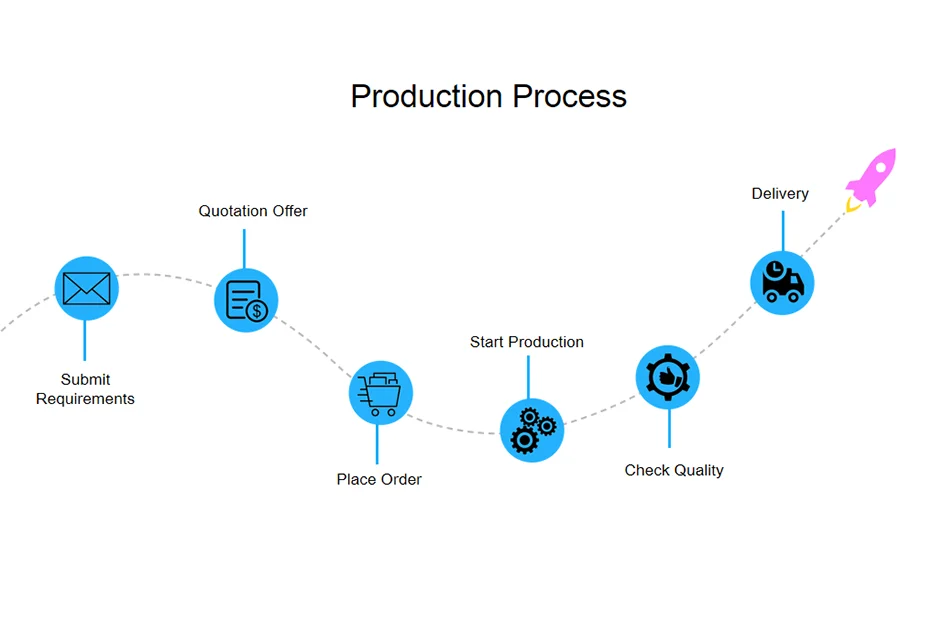
How To Make Custom Parts?
1, Send us your requirement
2, Quotation offer
3, Place order
4, Start Production
5, Check Quanlity
6, Ship and Delivery
Materials- Standard ABS
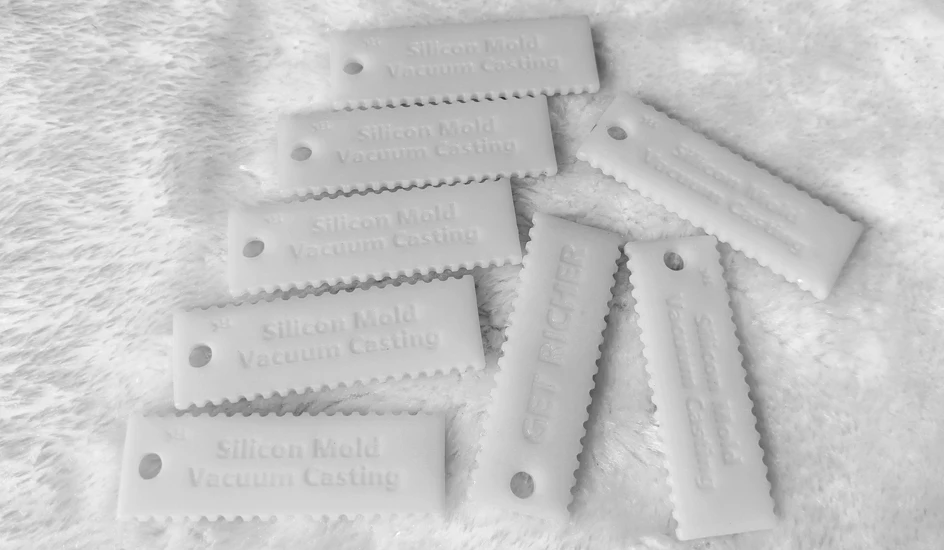
Technology Silicon Mold Vacuum Casting
Material Standard ABS
Original Color White/Black/Custom Color
Thermal Deformation 70-100°C
Hardness 83D
Surface Situation Slight Injection Marks And Scratches
Printing Platform Size 900*650*450mm
Flexural modulus 2000-2200 Mpa
Flexural strength 80-100 Mpa
Tensile strength 75-85 MPa
Elongation at break 8-16 %
Impact strength notched Izod 12 KJ/m²
Tolerance The local accuracy of the product is between 0.3-0.5mm~5 ‰, while overall accuracy is hard to control
Post Process Assembly,Insect copper nuts, Physical polishing,Painting, Electroplating, Silkscreen, Water transfer printing, Coating
Wall thickness required 0.8mm above, big parts according to 3D drawings
The advantages of Silicon Mold Vacuum Casting Standard ABS are:
1.Accurate Replication: Precisely reproduces ABS part properties and details.
2.Smooth Finishes: Results in parts with a polished, injection-molded-like surface.
3.Cost-Efficiency: More affordable than high-volume methods like injection molding.
4.Rapid Production: Quick turnaround for small to medium production runs.
5.Design Versatility: Allows for intricate designs and undercuts in the final parts.
6.Prototyping Excellence: Ideal for prototyping and functional testing before mass production.
7.Low-Volume Flexibility: Suited for small-batch production needs.
The disadvantages of Silicon Mold Vacuum Casting Standard ABS are:
1.Limited Material Properties: The properties of the final ABS parts may not perfectly match those of high-grade injection-molded ABS.
2.Not Ideal for High Volumes: Best suited for low to medium production volumes; may not be cost-effective for large-scale production.
3.Mold Wear and Tear: The silicone molds used in this process can degrade over time, affecting the quality and longevity of casts.
4.Lead Time: Involves lead time for mold creation and curing, which can impact project timelines.
Temperature-Resistant ABS
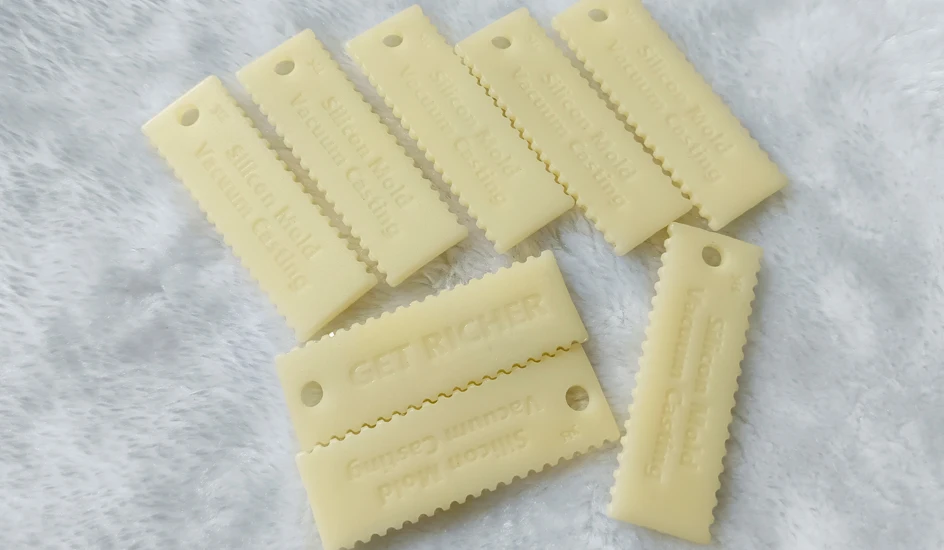
Technology Silicon Mold Vacuum Casting
Material Temperature-Resistant ABS
Original Color White/Black/Custom Color
Thermal Deformation 100-150°C
Hardness 80D
Surface Situation Slight Injection Marks And Scratches
Printing Platform Size 900*650*450mm
Flexural modulus 2000-2200 Mpa
Flexural strength 90-115 Mpa
Tensile strength 55-60 MPa
Elongation at break 8-16 %
Impact strength notched Izod 35 KJ/m²
Tolerance The local accuracy of the product is between 0.3-0.5mm~5 ‰, while overall accuracy is hard to control
Post Process Assembly,Insect copper nuts, Physical polishing,Painting, Electroplating, Silkscreen, Water transfer printing, Coating
Wall thickness required 0.8mm above, big parts according to 3D drawings
The advantages of Silicon Mold Vacuum Casting Temperature-Resistant ABS are:
1.Enhanced Heat Resistance: Temperature-resistant ABS can withstand higher temperatures compared to standard ABS, expanding its applications in heat-exposed environments.
2.Durable and Sturdy: Parts made from temperature-resistant ABS maintain their structural integrity and properties even at elevated temperatures, ensuring durability.
3.Wide Application Range: Ideal for parts needed in various industries, such as automotive, aerospace, and electronics, where exposure to heat is common.
4.Good Chemical Resistance: Temperature-resistant ABS typically possesses good resistance to chemicals, enhancing its suitability for diverse industrial environments.
The disadvantages of Silicon Mold Vacuum Casting Temperature-Resistant ABS are:
1.Limited Heat Resistance: While temperature-resistant ABS can withstand higher temperatures than standard ABS, it still has temperature limits and may deform or lose properties at very high temperatures.
2.Material Cost: Temperature-resistant ABS can be more expensive than standard ABS, increasing the overall cost of the vacuum casting process.
3.Complex Molding Process: Achieving temperature resistance in ABS may require a more complex molding process, making it harder and more time-consuming to create the silicone mold.
4.Mold Wear and Tear: The higher temperatures involved can accelerate wear and tear on the silicone mold, reducing its lifespan and affecting the quality of casts.
Flame-Retardant ABS

Technology Silicon Mold Vacuum Casting
Material Flame-Retardant ABS
Original Color White/Black/Custom Color
Thermal Deformation 70-80°C
Hardness 82D
Surface Situation Slight Injection Marks And Scratches
Printing Platform Size 900*650*450mm
Flexural modulus 2100-2300 Mpa
Flexural strength 80-90 Mpa
Tensile strength 60-70 MPa
Elongation at break 8-10 %
Impact strength notched Izod 15 KJ/m²
Tolerance The local accuracy of the product is between 0.3-0.5mm~5 ‰, while overall accuracy is hard to control
Post Process Assembly,Insect copper nuts, Physical polishing,Painting, Electroplating, Silkscreen, Water transfer printing, Coating
Wall thickness required 0.8mm above, big parts according to 3D drawings
The advantages of Silicon Mold Vacuum Casting Flame-Retardant ABS are:
1.Enhanced Safety: Flame-retardant ABS provides increased fire safety by resisting ignition and slowing down the spread of flames.
2.Compliance with Regulations: Ideal for applications where meeting fire safety and regulatory standards is essential, such as in the automotive and electronics industries.
3.Durable and Functional: Maintains the durability and functionality of ABS while incorporating flame-retardant properties, making it suitable for a wide range of applications.
4.Wide Applicability: Useful in environments where fire safety is a concern, including electrical enclosures, automotive interiors, and consumer electronics.
The disadvantages of Silicon Mold Vacuum Casting Flame-Retardant ABS are:
1.Material Complexity: Flame-retardant ABS is a more complex material, making the casting process potentially more challenging.
2.Cost: Flame-retardant ABS can be more expensive than standard ABS, increasing overall project costs.
3.Limited Material Options: The choice of flame-retardant materials may be limited compared to standard ABS, restricting material options for the process.
PC

Technology Silicon Mold Vacuum Casting
Material PC
Original Color White/Black/Translucent/Custom Color
Thermal Deformation 50-60°C
Hardness 80D
Surface Situation Slight Injection Marks And Scratches
Printing Platform Size 900*650*450mm
Flexural modulus 1700-1800 Mpa
Flexural strength 80-90 Mpa
Tensile modulus 1900-2000 MPa
Tensile strength 35-40 MPa
Elongation at break 5-6 %
Impact strength notched Izod 18 KJ/m²
Tolerance The local accuracy of the product is between 0.3-0.5mm~5 ‰, while overall accuracy is hard to control
Post Process Assembly,Insect copper nuts, Physical polishing,Painting, Electroplating, Silkscreen, Water transfer printing, Coating
Wall thickness required 0.8mm above, big parts according to 3D drawings
The advantages of Silicon Mold Vacuum Casting PC are:
1.High Impact Resistance: PC is one of the most impact-resistant thermoplastics available, making it suitable for applications where parts need to withstand mechanical stress and potential impacts.
2.Optical Clarity: PC offers excellent optical clarity and transparency, making it ideal for parts that require see-through or light-transmitting properties, such as lenses, covers, and protective shields.
3.Dimensional Stability: Parts produced with PC maintain their shape and dimensions even under temperature fluctuations, ensuring consistent performance.
4.Chemical Resistance: PC has good resistance to many chemicals, making it suitable for applications where exposure to various substances is a concern.
5.Low Volume Production: Silicone mold vacuum casting is well-suited for producing small to medium quantities of PC parts, especially when traditional manufacturing methods would be cost-prohibitive for low-volume runs.
The disadvantages of Silicon Mold Vacuum Casting PC are:
1.Lead Time: The production process, including mold creation, curing, and casting, can take several days to complete. This may not be suitable for projects with extremely tight timelines.
2.Mold Wear and Tear: Silicone molds have a limited lifespan and can wear out over time, especially when used with resins that have high mechanical properties like PC. Frequent mold replacement may be necessary for large production runs.
3.Post-Processing Required: Cast PC parts may require post-processing, such as trimming, sanding, or polishing, to achieve the desired surface finish and dimensional accuracy.
4.Material Shrinkage: PC resin can experience some shrinkage during the curing process, which may require adjustments to the mold design to compensate for dimensional changes.
5.Limited Material Recycling: The excess or waste material generated during silicone mold vacuum casting with PC is typically not recyclable for future use.
6.Cost: While this process can be cost-effective for low-volume production of PC parts, it may have higher per-unit costs compared to traditional manufacturing methods like injection molding for larger production runs.
PP

Technology Silicon Mold Vacuum Casting
Material PP
Original Color White/Black/Custom Color
Thermal Deformation 50-60°C
Hardness 75-83D
Surface Situation Slight Injection Marks And Scratches
Printing Platform Size 900*650*450mm
Flexural modulus 600-1300 Mpa
Flexural strength 20-50 Mpa
Tensile strength 25-35 MPa
Elongation at break 5-6 %
Impact strength notched Izod 18 KJ/m²
Tolerance The local accuracy of the product is between 0.3-0.5mm~5 ‰, while overall accuracy is hard to control
Post Process Assembly,Insect copper nuts, Physical polishing,Painting, Electroplating, Silkscreen, Water transfer printing, Coating
Wall thickness required 0.8mm above, big parts according to 3D drawings
The advantages of Silicon Mold Vacuum Casting PP are:
1.Chemical Resistance: PP is highly resistant to many chemicals, acids, and bases, making it suitable for applications where parts are exposed to corrosive substances.
2.Low Density: PP has a low density, which means it is lightweight. This is advantageous for applications where weight reduction is important, such as automotive components.
3.Good Electrical Insulation: PP is a good electrical insulator, making it suitable for electrical and electronic applications.
4.Flexibility and Toughness: PP has a good balance of flexibility and toughness, making it resistant to impact and fatigue. It can withstand bending and repeated use.
5.Low Moisture Absorption: PP has low moisture absorption properties, which is advantageous in applications where exposure to moisture or humidity is a concern.
6.Low-Volume Production: Silicone mold vacuum casting is well-suited for producing small to medium quantities of PP parts, especially when traditional manufacturing methods would be cost-prohibitive for low-volume runs.
The disadvantages of Silicon Mold Vacuum Casting PP-Polypropylene are:
1.Lead Time: The production process, including mold creation, curing, and casting, can take several days to complete. This may not be suitable for projects with extremely tight timelines.
2.Mold Wear and Tear: Silicone molds have a limited lifespan and can wear out over time, especially when used with resins that have special additives or reinforcements like PP. Frequent mold replacement may be necessary for large production runs.
3.Post-Processing Required: Cast PP parts may require post-processing, such as trimming, sanding, or surface finishing, to achieve the desired appearance and dimensional accuracy.
4.Material Shrinkage: PP resin can experience some shrinkage during the curing process, which may require adjustments to the mold design to compensate for dimensional changes.
5.Limited Material Recycling: The excess or waste material generated during silicone mold vacuum casting with PP is typically not recyclable for future use.
6.Limited Temperature Resistance: PP has a relatively low heat distortion temperature, which means it may deform or lose structural integrity at elevated temperatures. It is not suitable for high-temperature applications.
In summary, silicone mold vacuum casting with PP offers the advantages of chemical resistance, low density, and flexibility. However, it comes with limitations such as lead time, mold wear, and the need for post-processing. Careful consideration of project requirements and materials is essential when choosing this method for 3D printing projects using PP.
Nylon
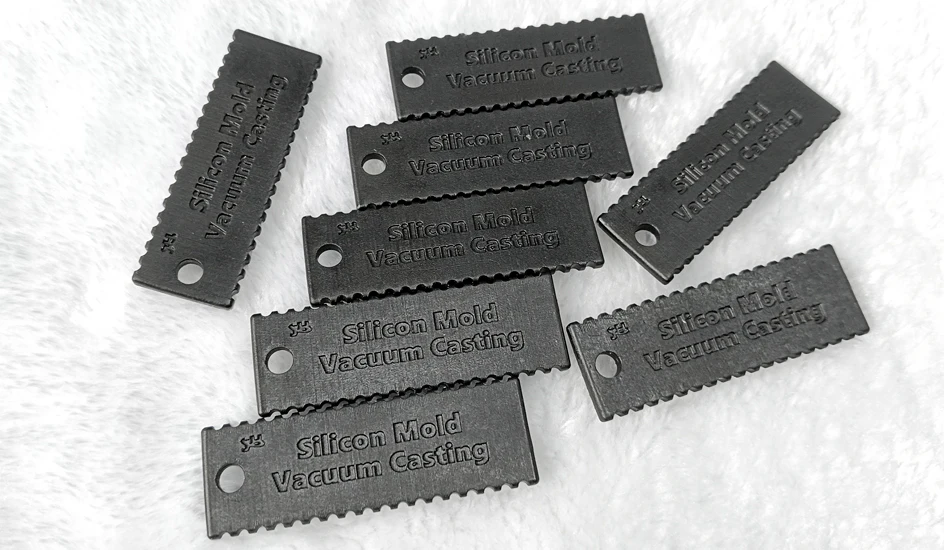
Technology Silicon Mold Vacuum Casting
Material Nylon
Original Color White/Black/Custom Color
Thermal Deformation 100-120°C
Hardness 87D
Surface Situation Slight Injection Marks And Scratches
Printing Platform Size 900*650*450mm
Flexural modulus 1800-2000 Mpa
Flexural strength 80-92 Mpa
Tensile strength 50-60 MPa
Elongation at break 10-12 %
Impact strength notched Izod 17 KJ/m²
Tolerance The local accuracy of the product is between 0.3-0.5mm~5 ‰, while overall accuracy is hard to control
Post Process Assembly,Insect copper nuts, Physical polishing,Painting, Electroplating, Silkscreen, Water transfer printing, Coating
Wall thickness required 0.8mm above, big parts according to 3D drawings
The advantages of Silicon Mold Vacuum Casting Nylon are:
1.High Mechanical Strength: Nylon parts produced through this process exhibit excellent mechanical properties, including high tensile strength, toughness, and impact resistance. This makes Nylon suitable for demanding applications.
2.Durability: Nylon is known for its durability and resistance to wear and tear, making it ideal for components that need to withstand friction and abrasion.
3.Chemical Resistance: Nylon has good resistance to many chemicals, oils, and solvents, making it suitable for applications where exposure to various substances is a concern.
4.Low Friction Coefficient: Nylon has a low coefficient of friction, which makes it ideal for applications involving moving parts or sliding mechanisms.
5.Flexibility: Nylon parts can exhibit a degree of flexibility, depending on the specific type of Nylon used. This makes it suitable for applications that require a balance of rigidity and flexibility.
6.Low-Volume Production: Silicone mold vacuum casting is well-suited for producing small to medium quantities of Nylon parts, especially when traditional manufacturing methods would be cost-prohibitive for low-volume runs.
The disadvantages of Silicon Mold Vacuum Casting Glass fiber Nylon are:
1.Lead Time: The production process, including mold creation, curing, and casting, can take several days to complete. This may not be suitable for projects with extremely tight timelines.
2.Mold Wear and Tear: Silicone molds have a limited lifespan and can wear out over time, especially when used with resins that have high mechanical properties like Nylon. Frequent mold replacement may be necessary for large production runs.
3.Post-Processing Required: Cast Nylon parts may require post-processing, such as trimming, sanding, or surface finishing, to achieve the desired appearance and dimensional accuracy.
4.Material Shrinkage: Nylon resin can experience some shrinkage during the curing process, which may require adjustments to the mold design to compensate for dimensional changes.
5.Limited Material Recycling: The excess or waste material generated during silicone mold vacuum casting with Nylon is typically not recyclable for future use.
6.Hygroscopic Nature: Nylon is hygroscopic, meaning it can absorb moisture from the environment over time. This may affect its mechanical properties if not properly handled and stored.
POM
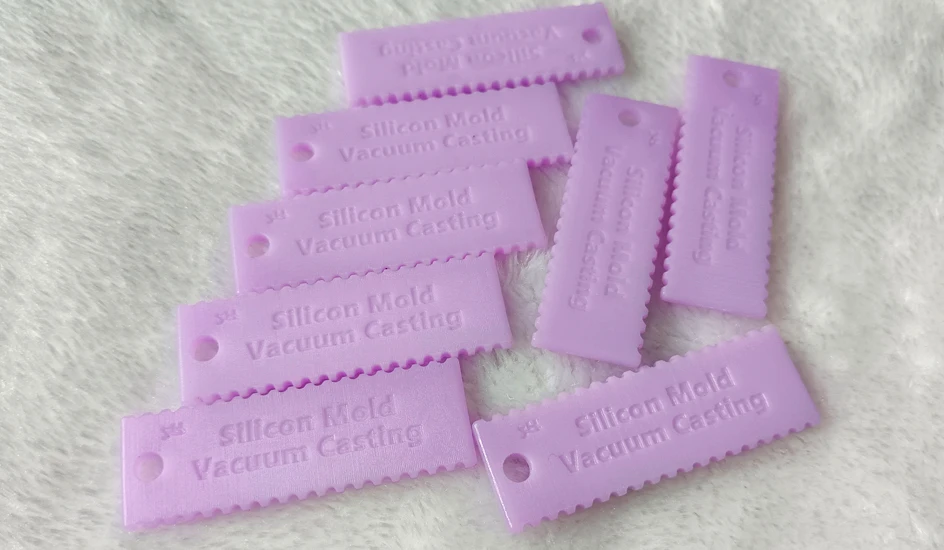
Technology Silicon Mold Vacuum Casting
Material POM
Original Color White/Black/Custom Color
Thermal Deformation 70-80°C
Hardness 80D
Surface Situation Slight Injection Marks And Scratches
Printing Platform Size 900*650*450mm
Flexural modulus 2400-2500 Mpa
Flexural strength 100-110 Mpa
Tensile strength 60-70 MPa
Elongation at break 10-12 %
Impact strength notched Izod 17 KJ/m²
Tolerance The local accuracy of the product is between 0.3-0.5mm~5 ‰, while overall accuracy is hard to control
Post Process Assembly,Insect copper nuts, Physical polishing,Painting, Electroplating, Silkscreen, Water transfer printing, Coating
Wall thickness required 0.8mm above, big parts according to 3D drawings
The advantages of Silicon Mold Vacuum Casting POM are:
1.Excellent Mechanical Properties: POM exhibits outstanding mechanical properties, including high tensile strength, stiffness, and impact resistance. It is often used in applications that require robust and durable components.
2.Low Friction: POM has a low coefficient of friction, making it ideal for parts involving sliding or rotating movements. It is commonly used in gears, bearings, and other components where reduced friction is crucial.
3.Dimensional Stability: POM has excellent dimensional stability, which means that parts made from this material maintain their shape and size even under temperature variations and mechanical stress.
4.Chemical Resistance: POM is resistant to many chemicals, including solvents, oils, and fuels, making it suitable for applications where exposure to various substances is a concern.
5.Low Moisture Absorption: POM has low moisture absorption properties, which is advantageous in applications where exposure to moisture or humidity can affect performance.
6.Low-Volume Production: Silicone mold vacuum casting is well-suited for producing small to medium quantities of POM parts, especially when traditional manufacturing methods would be cost-prohibitive for low-volume runs.
The disadvantages of Silicon Mold Vacuum Casting POM are:
1.Lead Time: The production process, including mold creation, curing, and casting, can take several days to complete. This may not be suitable for projects with extremely tight timelines.
2.Mold Wear and Tear: Silicone molds have a limited lifespan and can wear out over time, especially when used with resins that have high mechanical properties like POM. Frequent mold replacement may be necessary for large production runs.
3.Post-Processing Required: Cast POM parts may require post-processing, such as trimming, sanding, or surface finishing, to achieve the desired appearance and dimensional accuracy.
4.Material Shrinkage: POM resin can experience some shrinkage during the curing process, which may require adjustments to the mold design to compensate for dimensional changes.
5.Limited Material Recycling: The excess or waste material generated during silicone mold vacuum casting with POM is typically not recyclable for future use.
6.Cost: While this process can be cost-effective for low-volume production of POM parts, it may have higher per-unit costs compared to traditional manufacturing methods like injection molding for larger production runs.
In summary, silicone mold vacuum casting with POM offers the advantages of excellent mechanical properties, low friction, and chemical resistance. However, it comes with limitations such as lead time, mold wear, and the need for post-processing. Careful consideration of project requirements and materials is essential when choosing this method for 3D printing projects using POM.
Silicon


Technology Silicon Mold Vacuum Casting
Material Silicon
Original Color White/Black/Custom Color
Thermal Deformation 50-70°C
Surface Situation Slight Injection Marks And Scratches
Printing Platform Size 900*650*450mm
Tolerance The local accuracy of the product is between 0.3-0.5mm~5 ‰, while overall accuracy is hard to control
Hardness: Shore 30A, 40A, 50A, 60A, 70A, 80A, 90A
Wall thickness required 0.8mm above, big parts according to 3D drawings
The advantages of Silicon are:
1.Elastomeric Properties: Silicone rubber exhibits excellent elastomeric properties, including flexibility and resilience. It is ideal for producing parts that need to be soft, pliable, and able to return to their original shape after deformation.
2.Chemical Resistance: Silicone is resistant to many chemicals, oils, and solvents, making it suitable for applications where exposure to various substances is a concern.
3.Low-Volume Production: Silicone mold vacuum casting is well-suited for producing small to medium quantities of flexible silicone parts, especially when traditional manufacturing methods would be cost-prohibitive for low-volume runs.
4.Customization: Silicone materials can be tinted, pigmented, or blended to achieve different colors or meet specific aesthetic requirements.
The disadvantages of Silicon are:
1.Lead Time: The production process, including mold creation, curing, and casting, can take several days to complete. This may not be suitable for projects with extremely tight timelines.
2.Mold Wear and Tear: Silicone molds have a limited lifespan and can wear out over time, especially when used with resins that have special additives or reinforcements. Frequent mold replacement may be necessary for large production runs.
3.Post-Processing Required: Cast silicone parts may require post-processing, such as trimming, sanding, or surface finishing, to achieve the desired appearance and dimensional accuracy.
4.Material Shrinkage: Silicone resin can experience some shrinkage during the curing process, which may require adjustments to the mold design to compensate for dimensional changes.
5.Cost: While this process can be cost-effective for low-volume production of flexible silicone parts, it may have higher per-unit costs compared to traditional manufacturing methods like injection molding for larger production runs.
For Aerospace, Automotive and Motorcycle Industry

For Figurer, Fashion, Wearables

For Figurer, Fashion, Wearables

FAQ of custom 3d printing
Q: Can I 3D print custom or personalized objects?
A: Yes, 3D printing is great for creating custom or personalized objects, from prototypes to unique gifts.
Q: What file format is required for 3D printing?
A: The most common file format is STL , but services might accept other formats as well, eg: STP, obj
Q: How Can I send you the files?
A: You can send us your requirements by Aliexpress chat or mail to jh-aliexpress@hotmail dot com.
Q: What technology do you provide?
A: We provide multi-technologies: SLA, SLS, SLM, MJF, and DLP technologies, Silicon Mold Vacuuming Casting, and CNC machining, Laser Cut services.
Q: What materials can you provide?
A: We supply multi-materials: Resin, Nylon, Nylon+glass fiber, Red Wax, Aluminum, Stainless Steel, Titanium alloy, Brass, ABS, PP, PC, POM, Acrylic, PVC...
Q: How long does it take to 3D print an object?
A: Print time depends on the size, complexity, and the chosen printing speed. Small objects might take a few hours, while large and complex ones can take several days.
Q: Is post-processing required for 3D printed parts?
A: It depends on the desired finish. Post-processing, such as sanding, painting, or assembly, might be necessary for some applications.
Q: Are there size limitations in 3D printing services?
A: Yes, each 3D printer has a specific build volume, so there can be limitations on the size of objects that can be printed.
Q: Are there any design considerations for 3D printing?
A: Yes, designing for 3D printing involves considerations like support structures, layer orientation, and wall thickness to ensure successful printing.
Q: What industries use 3D printing services?
A: 3D printing is used in a wide range of industries, including aerospace, healthcare, automotive, architecture, and consumer goods.






